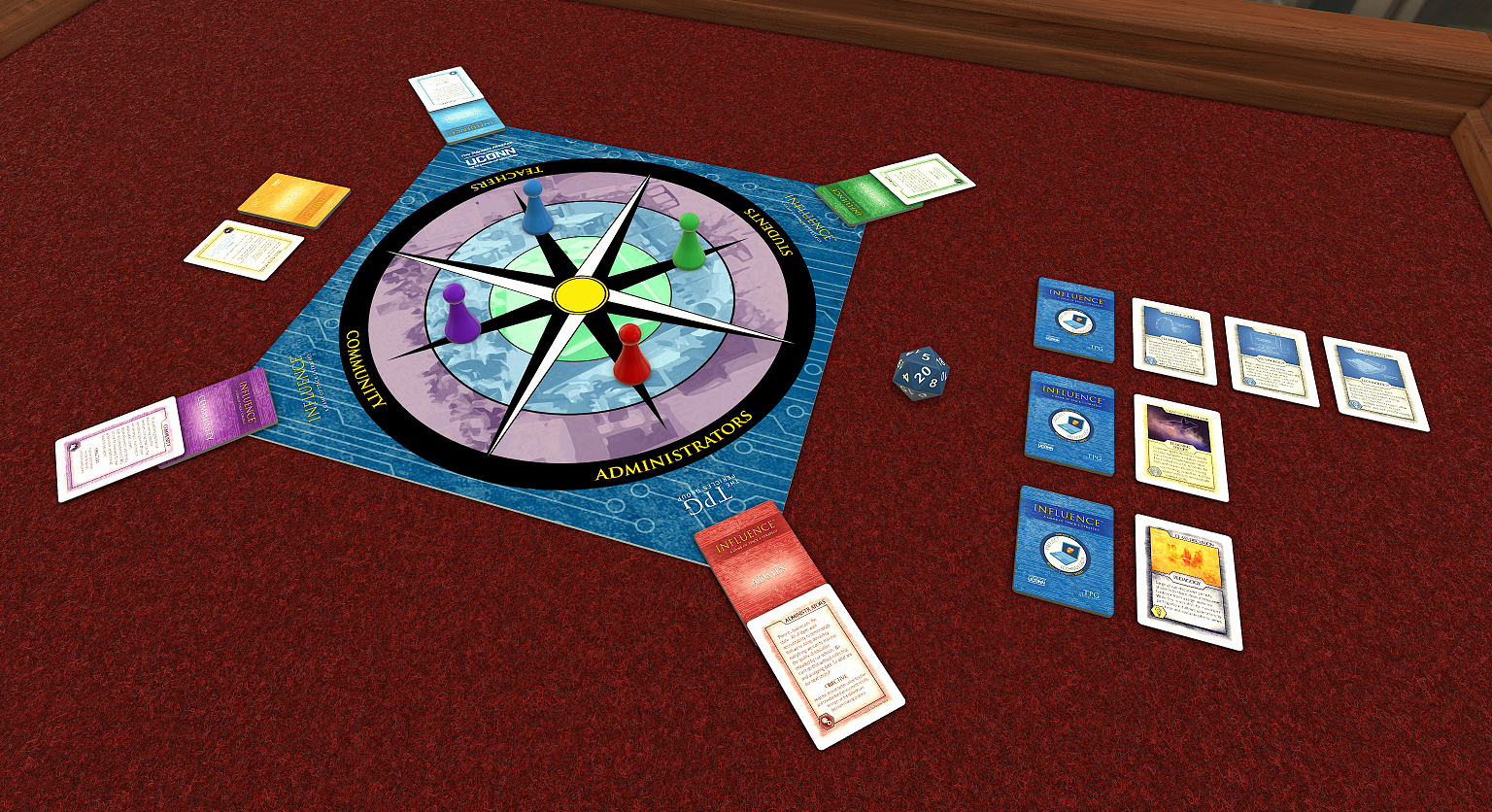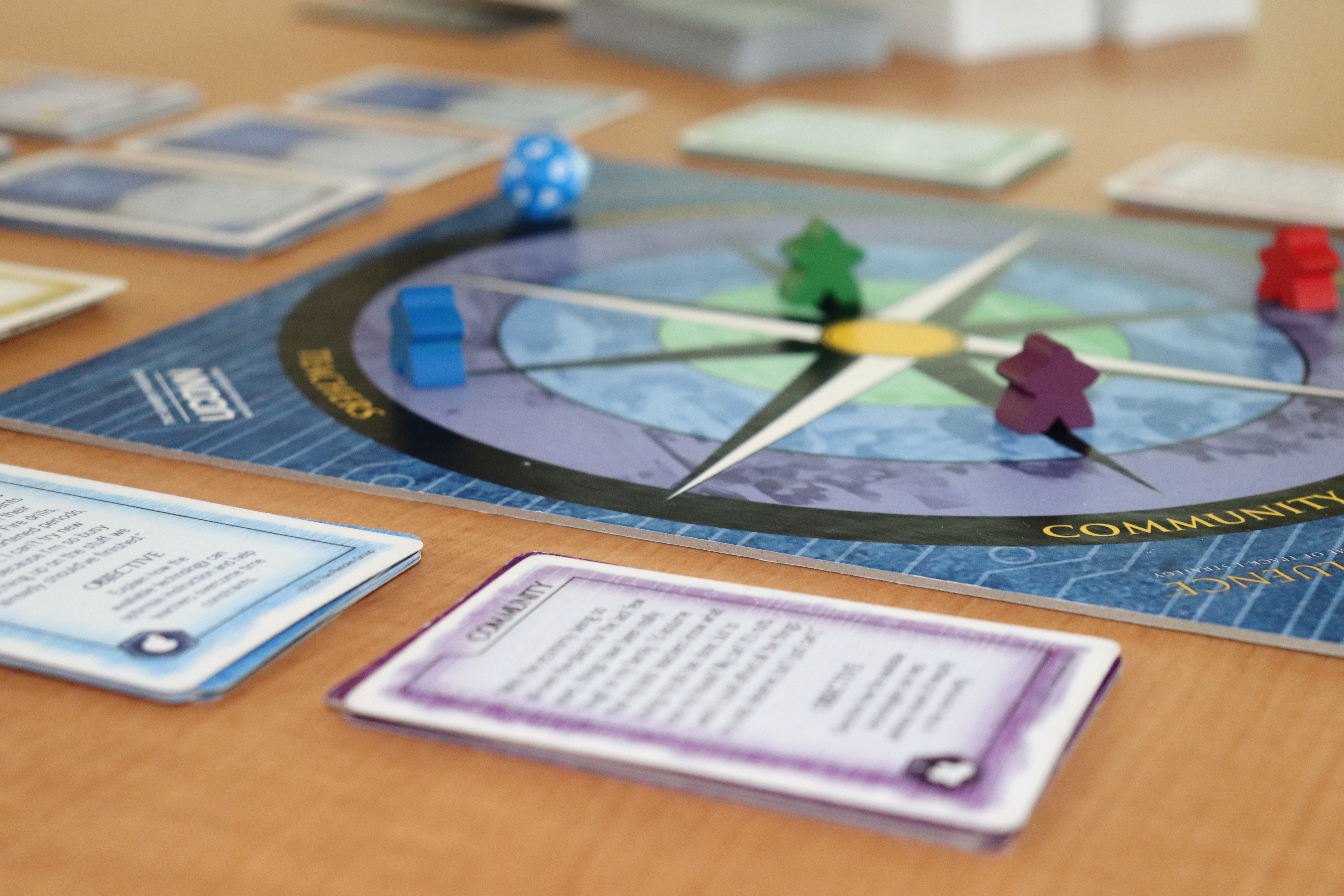
Influence™ is an instructional tabletop game designed to encourage the playful application and evaluation of technology, pedagogy, content knowledge, and learning theory integration, implementation, and management skills. Rather than acting in direct competition, players collaborate to analyze and balance the priorities of multiple stakeholder groups, maintain positive influence with those stakeholders, and produce TPACK-oriented initiatives capable of addressing multiple school district challenges at the same time.
A full album of Influence™ game cards and components is available HERE.
A FREE, fully-digital, publicly-available version of Influence™ can be accessed HERE (requires installation of Tabletop Simulator to play).


The game consists of:
- One (1) Game Board
- Four (4) Stakeholder game pieces
- One (1) seventy-two (72)-card Influence™ deck:
- Eight (8) Administrator cards
- Eight (8) Teacher cards
- Eight (8) Community cards
- Eight (8) Student cards
- Ten (10) Technology cards
- Ten (10) Pedagogy cards
- Ten (10) Learning Theory cards
- Ten (10) Event cards
- One (1) 20-sided die
![]()
In Influence™, gameplay is measured in rounds, each round representing one school year. At the start of each round, players are provided with a series of available resources/initiatives (as defined by face-up cards) and operate as a team of Technology Coordinators working toward a shared goal: use TPACK-style integration to address as many district challenges as possible while satisfying as many Stakeholder groups (i.e., Teachers, Students, Administrators, Community) as possible. Upon preparing and presenting a proposal, players switch roles from Technology Coordinators to Mediators and evaluate the quality and feasibility of their work from the perspective of each Stakeholder group.
![]()
- Separate and shuffle each set of Technology, Pedagogy, Learning Theory, and Stakeholder (i.e., Administrators, Teachers, Students, Community) cards. Event cards can be set aside (rules for incorporating Event cards are described separately).
- Organize the game board and cards as pictured.
- Reveal the top one (1) card from the Pedagogy and Learning Theory decks; reveal the top three (3) cards from the Technology deck. These Pedagogies, Learning Theories, and Technologies represent the group’s available resources and professional development initiatives for the first school year (round).
- To begin the first school year (round), reveal the top one (1) card from each Stakeholder deck (i.e., Administrators, Teachers, Students, Community). These cards describe specific objectives that must be fulfilled within the school year to maintain influence with each Stakeholder group. Importantly, Stakeholder cards remain in play until they are 1) resolved by the player group, 2) altered by an Event card, or 3) a Stakeholder game piece reaches the edge of the board (i.e., the game ends).
- Adopting the role of Technology Coordinators, the full player group (i.e., everyone playing the game) may spend up to six (6) minutes collaboratively creating a technology integration plan that 1) satisfies as many Stakeholder objectives as possible and 2) strategically incorporates the available district resources/initiatives.
- N.B.: Planning discussions often include determination of which Stakeholder objectives should be prioritized and how the Technology, Pedagogy, and Learning Theory cards can/should be incorporated. The group DOES NOT need to incorporate all Technology, Pedagogy, and Learning Theory cards into their technology integration plan each round, but doing so yields an end-game bonus.
- After six (6) minutes have passed, one player becomes the round’s Spokesperson. The Spokesperson is responsible for making a brief “elevator pitch” statement describing the group’s technology integration plan (it may help to think of this as the final proposal a technology coordinator would make before a school district’s Board of Education). Players may volunteer to take on the Spokesperson role, or one may be selected by other means (e.g., whomever last touched their mobile device).
- All players who are NOT the round’s Spokesperson become Mediators. Mediators are responsible for evaluating the Spokesperson‘s statement on behalf of a particular Stakeholder group. For example, the Mediator acting on behalf of Teachers is responsible for listening to and assessing the Spokesperson‘s statement in terms of whether or not it addressed the given Teacher objective (as described on the revealed Teacher Stakeholder card). ALL Mediators should roll a twenty-sided die to determine their “Stakeholder Disposition”:
- Dice Roll 1-5 = Easy-Going (e.g., very low expectations, fairly uncritical, tends to focus on strengths over weaknesses)
- Dice Roll 6-15 = Neutral (e.g., approaches the proposal objectively and dispassionately, focuses on both strengths and weaknesses)
- Dice Roll 16-20 = Hard Ass (e.g., very high expectations, highly-critical, provides significant feedback, tends to focus on weaknesses over strengths)
- Once they have determined their dispositions, Mediators must decide who will represent each of the four Stakeholder groups. There should be a minimum of one Mediator per Stakeholder group such that all groups are represented.
- N.B.: If playing with four (4) or fewer players, the Spokesperson may serve in both the Spokesperson AND Mediator roles as needed; alternatively or in addition, one Mediator may represent multiple Stakeholder groups at once.
- The Spokesperson takes up to one (1) minute to summarize the group’s technology integration plan, highlighting the relationship between resources, initiatives, and Stakeholder objectives.
- N.B.: Remember, it is not necessary to utilize all Technologies, Pedagogies, and Learning Theories for every technology integration plan; you simply get an end-game bonus for doing so.
- After the Spokesperson has completed their statement, Mediators take up to two (2) minutes to discuss their perspectives on the statement. Perspectives should be shaped by the Mediators‘ randomly-determined “Stakeholder Dispositions” (Easy-Going, Neutral, Hard Ass).
- Each Mediator‘s evaluation determines whether and to what extent their Stakeholder group’s objective was met, leading to changes in the players’ overall influence on each group:
- Completely Satisfied: The Stakeholder objective was addressed in full and clearly connected to the overarching technology integration plan; move the Stakeholder game piece one ring TOWARD the center of the game board (i.e., gain influence).
- Partially Satisfied: The Stakeholder objective was discussed but not well-described and/or loosely-connected with the broader technology integration plan; the Stakeholder game piece DOES NOT MOVE (i.e., unchanged influence).
- Unsatisfied: The Stakeholder objective was either not addressed or was addressed in a way ill-fitting the broader technology integration plan; move the Stakeholder game piece one ring AWAY from the center of the game board (i.e., lose influence).
- Once all Stakeholder game pieces have been moved, cards used as part of the technology integration plan (i.e., Technology, Pedagogy, Learning Theory) should be discarded. Replace discarded cards with the top one (1) card from the Pedagogy and Learning Theory decks and top one to three (1-3) cards from the Technology deck.
- Discard all Stakeholder cards that have been Completely or Partially Satisfied. Those that were Unsatisfied remain in play until addressed by the group.
- Begin the next school year (round) by replacing discarded Stakeholder cards with the top one (1) card from those Stakeholder decks.
- Continue play in this fashion (beginning at Step 5) until one of the following conditions is achieved:
- WIN: Players successfully maintain influence with all Stakeholder groups for five (5) full school years (rounds).
- LOSS: Players lose the trust of any/all Stakeholder groups before five (5) school years (rounds) have passed (i.e., a Stakeholder game piece reaches and would move beyond the outermost ring on the game board).
- Calculate the player group’s total level of influence based on the following criteria:
- [Point Values TBD]
![]()
For those seeking a bit more of a challenge (or to better simulate the real world chaos of a school environment), Event cards can be incorporated to create random effects that modify player and Stakeholder goals.
To utilize Event cards:
- Begin a game of Influence™ as described in the standard ruleset.
- Whenever you would reveal new Technology, Pedagogy, Learning Theory, and Stakeholder cards at the beginning of a school year (round), reveal the top one (1) card of the Event deck.
- Apply the revealed Event card’s effect for the school year (round) and proceed as normal.
- At the end of the school year (round), discard the current Event card and replace it with the top one (1) card from the Event deck.
- Continue until one of the standard end conditions is met.
